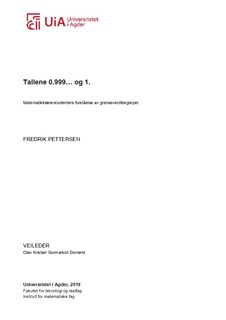Tallene 0.999... og 1 : Matematikklærerstudenters forståelse av grenseverdibegrepet
Abstract
The limit concept is a central concept in mathematics, especially in calculus.A good understanding of this concept is therefore important in orderto understand other concepts like differentiation and integration. Despitethis, students’ understanding og this concept often vary from the formalmathematical definition. It is therefore interesting and important to gainan overview and understanding of how students’ concept image may looklike, that you may teach accordingly. Just as important is it to gain insightinto how the concept images of pre-service mathematics teachers may looklike, because it will to a large degree affect how and what they will teachtheir students. Therefore, in this thesis, I will try to answer the followingresearch questions:•What does pre-service mathematics teachers think about the numbers0.999. . .an1?•How do they understand the limit concept?•What conceptions, and potential misconceptions, do they have?As a theoretical framework for the thesis I will use the theory of conceptdefinition and concept image by D. Tall & Vinner (1981) to explain whatit means to ahve a good mathematical understanding. I will also useAPOS theory from Dubinsky et al. (2005a, 2005b) to explain conceptionsof numbers with infinite decimals. In order to classify the different of thestudents I will use findings from Davis & Vinner (1986) and Williams (1991)who have identified common conceptions of the limit concept.Data was collected using both questionaires og qualitative interviews.The questionaire was given to a class of pre-service mathematics students.Three students was selected from a group of volunteers and they weresubsequently interviewed.The results from the questionaire showed that the majority of thestudents claimed that0.999. . . <1, but with differing opinions as to why.Several students used a method of comparing two decimal numbers thatled to a rejection of the idea that the two numbers were equal. Other usedapproximationarguments to argue that the numbers were almost equal,but not quite. Another recurring conception that the students had wasthat limits were unreachable. Such arguments also involved the idea ofinfinitesimals. The results also show that the students often used languagethat was dynamic in nature.
Description
Masteroppgave matematikkdidaktikk MA502 – Universitetet i Agder 2019

